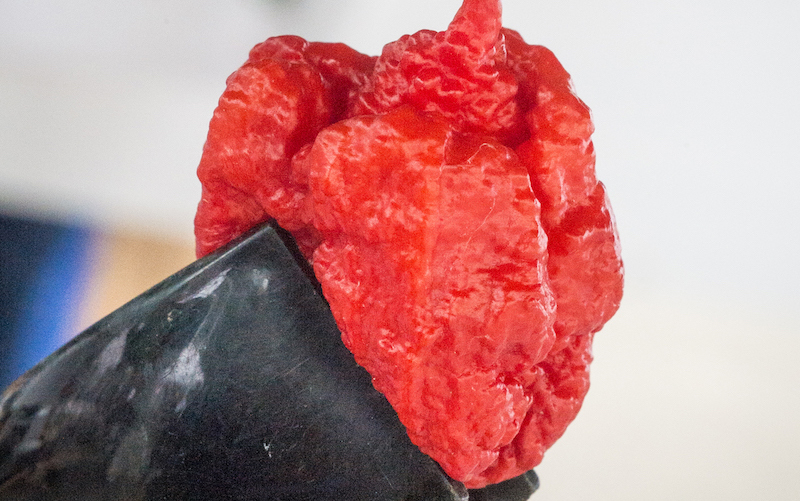
Clocking in at 600,000 Scoville heat units, the ghost pepper used to be the world’s hottest pepper. Until Ed Currie crossed a ghost pepper with a habanero, that is.
The result? A blistered-looking—and blisteringly hot—hot pepper. The Carolina Reaper measures 1.569 million Scoville heat units. Eating a Carolina Reaper raw has been compared to “eating molten lava” or “licking the sun.”
Currie is the self-described “owner, president, mad scientist and chef” at the PuckerButt Pepper Company. Thanks to his Carolina Reaper, the Guinness Book of World Records designated him the record holder for the world’s hottest pepper.
Now, besides operating the largest certified organic pepper farm in the U.S. and continually experimenting with even hotter cultivars, Currie frequently offers would-be pepper growers solid advice.
New to Peppers?
Currie recommends hot pepper growers wear disposable gloves when planting their seeds. (Both seeds and fruits of ghost peppers and similar plants contain capsaicin, which can irritate eyes, skin and mucous membranes.)
Still, he notes, “There’s nothing dangerous that can happen to you from a pepper. It’s all a chemical reaction that our brain perceives as heat. There’s no actual heat going on.”
So, when people suggest they’ve been burned by a pepper?
“When they say a hole gets put in their throat or their stomach, that’s impossible,” he continues. “There’s no heat involved. That’s all internet fodder.”
Check out this recipe for jam made from aji charapita peppers and peaches!
Common Mistakes
Currie has pepper-growing dialed in. He grows thousands of extra-hot peppers each year.
Currie also willingly guides gardeners like me who are new to these particular crops. (For my part, I’ve grown aji charapitas, but never anything hotter until now.)
The most common mistake we make? Planting hot pepper seeds too deeply and failing to allow enough time for germination. “Pepper seeds in the super-hot category can take up to six weeks to germinate,” he says.
And it can take 120 to 150 days from seed-starting until your first hot-and-spicy harvest. That may work for gardeners living in warm climates, but those of us in colder areas may want to start pepper seeds indoors as early as late December or early January.
“If you start seeds in April like you might with most vegetables, you’re probably going to get a frost before you get a harvest,” Currie explains.
Good Stock
Of course, before you go to all of that trouble, you’d better be certain your seed stock is legit. Case in point, it wasn’t until after I’d nurtured seeds for an “heirloom purple ghost pepper” that I noticed the online seller’s mediocre product reviews.
According to Currie, my seeds could be the real deal, but the odds aren’t great.
“The designation for an heirloom is 25 years after stability,” he explains. “And ghost peppers have only been in the United States since the mid to late 1980s. So, officially, if someone’s got [an heirloom] purple ghost pepper, mathematically it’s possible—but it’s probably just someone saying it’s a purple ghost pepper.”
For comparison, consider Currie’s Carolina Reaper. A botantist and geneticist declared the variety “stable” when the plant was in its tenth generation.
“And it doesn’t even become a cultivar until 15 generations after that,” Currie says. “Then I believe it’s 25 generations after that to become an heirloom.”
What are heirloom vegetables, and should you grow them?
A Better Start
To give his seeds a head start, Currie soaks them for a few hours in either a hydrogen peroxide solution or black tea.
“The hydrogen peroxide actually takes all of the hot stuff off [of the seed],” he says. “And the tannic acid [in the tea] kind of mimics the stomach of a bird and softens the seed casing, so that makes it easier to germinate.”
Currie recommends planting pepper seeds at about an eighth of an inch deep in moist—not waterlogged—soil. “If the seeds get too much water, they’ll get a fungus or mold before they can germinate,” he adds.
And once seeds do germinate? Currie waits until seedlings are six inches tall and then transplants them into larger cells.
“Then we wait until they’re a foot tall or more to transplant them into the ground,” he says. “That seems to work best.”
Respect the Reaper
Whatever your extra-hot pepper may be, you should wear protective gloves for their harvest and handling. And if you plan to dehydrate or cook with ghost peppers, Carolina Reapers or similarly spicy numbers, take them outside.
“I don’t recommend anybody do it inside their house!” Currie laughs.
He slices Carolina Reapers on a specially designated cutting board. And, to avoid overpowering capsaicin fumes, he operates his food dehydrator outdoors or in the garage.




